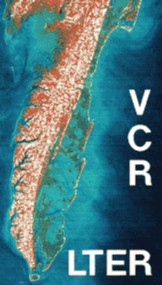 A second reversal in Hog Island shoreline change circa 1870. |

Michael Fenster and Bruce P.Hayden
Department of Environmental Sciences
|
 A second reversal in Hog Island shoreline change circa 1870. |

Michael Fenster and Bruce P.Hayden
Department of Environmental Sciences
|
Malcomb Sculley and Dave Watkins, undergraduate students at the University of Virginia, were supported for the summer by the National Science Foundation to study the history of the position of the shoreline along the Hog Island and to determine what changes in shoreline dynamics had occurred during the period of photographic coverage. Shoreline positions, aerial photographs, were measured along coast at 50 meters intervals. For the 7 kilometer long Hog Island there were 140 locations of position measurement along the coast. Using an error minimizing statistical procedure, the dates when the shoreline changed from erosion to accretion or accretion to erosion were determined. The frequency of these critical change dates for each of the 140 locations were plotted. The change did not happen the same year at all 140 locations. When summarized, the most common date of change was 1969. The north end of Hog island began to erode landward after this date and the south end began to accrete seaward.
The discovery at the LTER site on Hog Island of a reversal in the direction of shoreline change has since been shown to be true from New Jersey's coast to Florida's. It is not local to the VCR and thus we believe its cause to be a large scale processes. Places that had been eroding started to build seaward and accreting shorelines changed to erosion. This applies to about 2/3 of the 1500 kilometers of coast studied. This regional exploration of the NSF LTER finding was funded by FEMA and the lead in that study was Michael Fenster and Robert Dolan, VCR LTER affiliated scientists at the University of Virginia. All along the U. S. Atlantic coast the change date was in the mid- to late 1960s.
Using shoreline survey maps produced by the Coast and Geodetic Survey (more recently NOAA) we have found that a second critical point of change occurred at Hog Island in the 1870s when there was a change from accretion to erosion along the south end of Hog Island and from erosion to accretion along the north end of the island. This is the opposite of the pattern of change that occurred on Hog Island in the late 1960s. Two other coastal locations were subjected to the same kind of analysis. A second critical point of change occurred at Cape Hatteras in the 1870s when areas that were eroding started to accrete and areas that were accreting began to erode. This is the reversal of the pattern of change that occurred at Cape Hatteras in the late 1960s. At Cape May, NJ. a second period of shoreline change reversal occurred in the 1870s when areas that were eroding started to accrete and areas that were accreting began to erode. While data are not in hand to expand this study to Florida in the South and Cape Cod to the north do not exist, the 1960s reversal all along the coast supports the idea of a East Coast wide phenomenon in the 1870s.
In the period before the first ground surveys in 1852, the islands were probably as dynamic as they are today. Blackbeard used the Virginia coast as a safe haven. The shifting sands of the beaches and inlet made sailing dangerous and many were not willing to take the risk. The question then is were there reversals from erosion to accretion and accretion to erosion in earlier centuries. If so, the graph of critical years of change would contain multiple histogram peaks. This is a prediction of what a histogram of critical point dates would be like if there were an earlier reversals and we had a way to measure the position of the shoreline in these times. Such records exist in a more general form the landfroms of the islands. Scott Harris, a student who completed his graduate studies with support from the National Science Foundation, looked at the old landforms on Hog Island and concluded that in earlier times the island had gone through earlier periods of erosion and accretion reversals. Landscapes and ecosystem patterns on the VCR islands may exhibit a century-long quasi-periodic behavior driven by processes at the continental scale. The current hypothesis is that these changes are due to climate change. Specifically, century long changes in the number of winter storms and similar length changes in the strength of the summertime Bermuda High.
The current tendency to use erosion rates of the recent past to gauge the risks to be faced in the future. Doing so with a liner hypothesis is risky. It is also risky to assume that environmental changes such as carbon dioxide enrichment of the atmosphere during modern times is causes of all change.
Fenster, M. and R. Dolan 1994. Large-scale reversals in shoreline trends along the U.S. mid-Atlantic Coast. Geology 22:543-546.
Harris, M.S. 1992. The Geomorphology of Hog Island, Virginia: A Mid-Atlantic Coast Barrier. MS Thesis. University of Virginia, Charlottesville, Va.
Hayden, B. P. 1995. Islands on the go: the land must change to stay the same. Presentation at the national Science Foundation. On view at this URL.